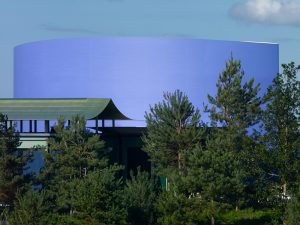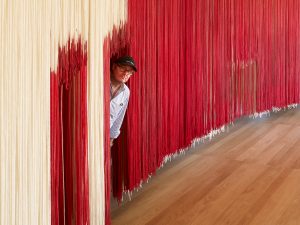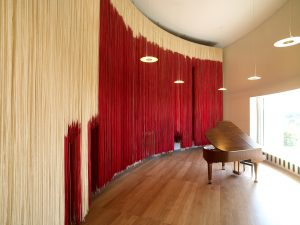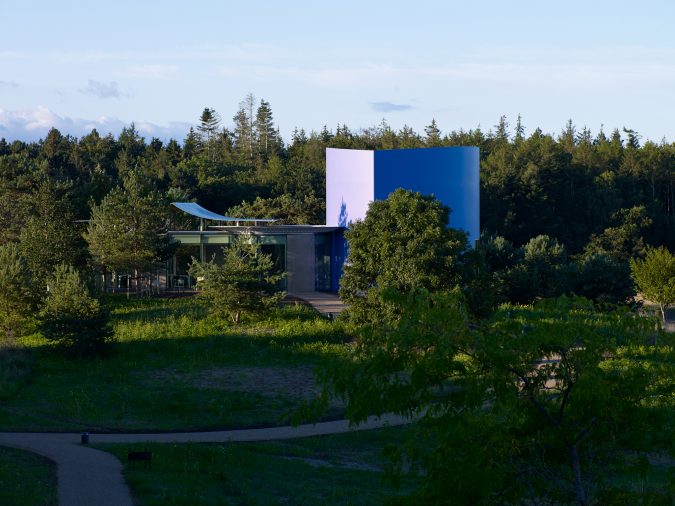High-end textile brand Kvadrat is shedding fresh light on the dynamic between architecture and art – a Gesamtkunstwerk – with the opening of The Triple Folly, a sculptural hospitality and conference venue at its HQ in Ebeltoft, Denmark.
The Triple Folly – a still life assembled on a hillock overlooking the sea – is three buildings and, at the same time, one building. It comprises a trio of volumes which each represent an item developed by Thomas Demand: a sheet of legal paper, a paper plate, and an American soda jerk’s hat. Equipped with these curiosities, he reached out to Caruso St. John architects with a compelling question, “Can you make this into architecture?”.
 A Gesamtkunstwerk is a ‘total artwork’ that unites different forms of art, design, and craft to create a cohesive whole in which various elements seamlessly complement each other. The Triple Folly embodies this harmonic approach: working closely together from the onset, Thomas Demand and Caruso St John architects co-developed the interior’s defining features, including surfaces, chairs, tables, lamps, and even the door handles.
A Gesamtkunstwerk is a ‘total artwork’ that unites different forms of art, design, and craft to create a cohesive whole in which various elements seamlessly complement each other. The Triple Folly embodies this harmonic approach: working closely together from the onset, Thomas Demand and Caruso St John architects co-developed the interior’s defining features, including surfaces, chairs, tables, lamps, and even the door handles.
The journey to the unveiling of The Triple Folly began when Anders Byriel, CEO of Kvadrat, invited Thomas Demand, one of the most acclaimed artists of his generation, to design a building at the company’s headquarters. The project represents the latest iteration of their celebrated long-term collaboration – and typifies the lasting, visionary relationships that are a cornerstone of the Kvadrat brand. Inside, visitors will encounter an expansive artwork crafted from suspended heavy wool threads Yes but by artist Rosemarie Trockel, which also works to elevate acoustic comfort. It was purchase in 2006 to be displayed at the HQ, and the ‘hat’ of The Triple Folly was made to fit the work seamlessly.

 Kvadrat offers a constellation of pioneering textiles and textile-related products. Mindful of this, Thomas Demand initially gravitated towards the idea of tents, an archetypal textile structure. Embracing this source of inspiration led the artist to research the history of tents. This process revealed their multidimensional role in society – from setting the stage for happy family events to protecting refugees and even providing accommodation for rulers in wartime.
Kvadrat offers a constellation of pioneering textiles and textile-related products. Mindful of this, Thomas Demand initially gravitated towards the idea of tents, an archetypal textile structure. Embracing this source of inspiration led the artist to research the history of tents. This process revealed their multidimensional role in society – from setting the stage for happy family events to protecting refugees and even providing accommodation for rulers in wartime.
Over time, Thomas Demand’s initial idea morphed into the vision of a pavilion – a variety of tent traditionally used to welcome visitors to exhibitions and other events. His train of thought was informed by the fact that art projects are integral to the culture at Kvadrat. Reflecting this, The Triple Folly will add new art to the picturesque landscape around the HQ, which is already dotted with works from celebrated artists Olafur Eliasson and Roman Signer for locals and visitors to enjoy.
The three elements that inspire The Triple Folly sculptural volumes reference an essential material in the work of Thomas Demand: paper. Consequently, the architects have chosen materials and seamless surfaces that capture the character of paper while filling the buildings with light and shadow.
The ‘hat’, an elliptical volume made of welded fiberglass plate that rises from the coastal landscape, provides a living room area. The legal paper, which features a faded yellow-and-black-lined folded ‘paper sheet’ made from translucent fiberglass, offers a vibrant space for meetings. The paper plate, also in fiberglass, is a formed sheet held above a cylindrical volume by thin columns, integrates a kitchen and a dining area. Each volume has its own entrance, leaving it up to visitors to experience the dialogue between art and architecture as they see fit.

